Vol 3 No. 19 TROPIC LIGHTNING NEWS May 6, 1968
Index
1ST BDE - A series of heliborne assaults and steady searching for possible
enemy infiltration by the 25th Inf Div's 2nd Bn, 14th Inf, ended with 193 dead
Communists, 2 detainees, and many captured enemy supplies during Operation Quyet
Thang.
"We had been participating in Operation Yellowstone a couple of months before
joining Quyet Thang," said Bn CO LTC Alfred M. Bracy of Petersburg, Va. "Our
purpose in Operation Yellowstone involved cutting off enemy supply routes along
the Cambodian border. Operation Quyet Thang provided new experiences for the
men," he added.
Leaving the 1st Bde base camp at Tay Ninh aroused quite a bit of conversation
from the men. "At first I didn't like the idea of leaving our area of
operations at Tay Ninh, but I guess it turned out all right. With all the
action the time has gone fast," remarked PFC Stephen L. Treacy of Whitesboro,
N.Y.
The first phase of the "Golden Dragon's" involvement in Quyet Thang took
place as the battalion airlifted into the Ho Bo Woods and conducted daily
reconnaissance in force operations. The various companies found large weapon
caches, but very little contact with the enemy.
Some of the men said finding the weapons caches was the most memorable action
of the whole operation. "I'll never forget that day I found that first
underground vault full of weapons and ammo," recalled PFC Larry R. Atchley of
Atlanta, Ga.
The battalion rounded up enough weapons and ammunition to arm an enemy
battalion. A total of 117 enemy rifles, including AK-50's, AK-47's, SKS
Carbines, M-1 Carbines, Chinese Communist Carbines, and Browning automatic
rifles were captured during a two week period.
The Dragons also uncovered five complete mortar tubes, base plates, tripod
legs, sight assemblies, and 437 mortar rounds.
In addition the 1st Bde soldiers destroyed or evacuated a RPG-2 and 2 RPG-7
rocket launchers; 310 RPG-7 and RPG-2 rockets; 320 RPG boosters; 12 122mm
rockets; 2 30-caliber machine guns; 1 Thompson submachine gun; 1 pistol; 522
hand grenades; 5,826 rounds of small arms ammunition; 76 Viet Cong protective
masks; 2,126 pounds of rice and numerous enemy documents.
"The highlight of the operation was the two all night battles 54 Kms
northwest of Saigon" remembered SP4 Gary L. Ford of Oakview, Calif. The Dragons
defeated a battalion of mixed North Vietnamese regulars and Viet Cong guerrillas
in two separate around the clock battles.
"Operation Quyet Thang has ended, but the men continue to talk about the busy
operation," reported one company commander, CPT Richard L. Endicott. "I'm sure
they all agree about it being one of the most memorable of our recent
activities," the Casper, Wyo., officer concluded.
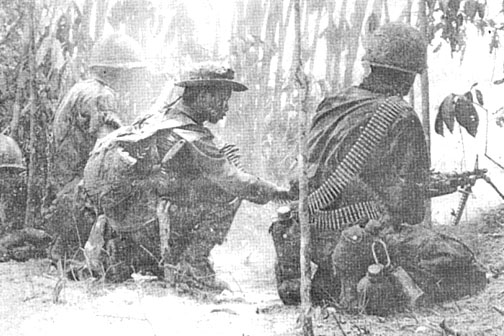 |
KIT CARSON - A Hoi Chanh rallier serving as a scout with the 25th Inf Div's 2nd Bn, 14th Inf, helps feed a belt of ammunition into an M-60 machine gun during an Operation Quyet Thong battle. (Photo By SGT Marty Caldwell) |
Wolfhounds Return After 59 Days Out
2ND BDE - "Wolfhounds" of the 25th Div's 2nd Bn, 27th Inf returned to Cu Chi
for a five-day rest after killing 328 Viet Cong and North Vietnamese during 59
consecutive days in the field.
LTC Winfred G. Skelton Jr., Bn CO, said his unit had tallied "an impressive
record" during the two months of hard fighting.
The battalion left the division base at Cu Chi early on January 31 to
reinforce Tan Son Nhut Air Base after the Viet Cong launched their massive Tet
offensive.
Since then, the Tropic Lightning soldiers have operated primarily in the
Saigon-Gia Dinh-Hoc Mon area, including several days of street fighting as they
pushed enemy troops from the capital early in February.
Skelton said he was "proud of the way the battalion acquitted itself. Every
time the VC decided to come out and fight, we defeated him."
In addition to the 382 Viet Cong killed by ground fire, helicopter
gunships supporting the 2nd Bn, 27th Inf, accounted for 86 more enemy dead.
Among the list of enemy supplies and equipment captured by the 2nd Bde
soldiers are: 113 automatic weapons, 28 machine guns, 98 small arms, 65
RPG-model rocket launchers, six mortars, 42,777 rounds of small arms
ammunition, 15 tons of rice and 2 1/2 tons of salt.
The Wolfhounds further destroyed 576 bunkers, tunnel complexes and other
enemy installations and military structures during the period.
Skelton said the battalion would resume operations after several days of
refresher training and rest at Cu Chi.
Regulars Fight Off Attack, 124 Viet Cong Killed
3RD BDE - The 3rd Bn, 22nd Inf, fought off a Viet Cong human wave attack 110 kms northwest of Saigon only hours after they had set up their night position.
The 3rd Bde, 25th Inf Div unit was taking part in the multi-division
Operation Toan Thang when the attack occurred.
The Bn had been heli-lifted into their position and set up their night
perimeter in a remote part of the jungle close to the Saigon River. Very early
in the morning, the camp came under heavy mortar attack. As the mortar fire
increased, the VC hit the battalion perimeter with a massive human wave attack.
One sector of the perimeter received the brunt of the attack and was quickly
reinforced by the reconnaissance unit. The Viet Cong began getting inside the
perimeter but an all-out effort drove them back.
Air strikes and artillery pounded the VC and the attack began to weaken. As
dawn broke, the enemy was driven back to the edge of the perimeter. The VC kept
trying to press the attack as their mortar rounds were pounding the "Regulars"
position.
By sunrise, the unit had successfully beaten off the attack and were joined
by the 2nd Bn (Mech), 22nd Inf, who had worked their way through six kms of
jungle to reinforce their sister battalion.
The two units gained complete control of the perimeter and received only
sporadic fire throughout the morning.
The first sweep of the area that morning produced 124 VC bodies while later
sweeps turned up 13 more to bring the total to 137 enemy killed. Also found
were 5 AK-47 rifles, 13 machine guns, 7 RPG launchers and 2 chicom carbines.
The day was climaxed by the presentation of Silver Stars to six Regulars of
the 3rd Bn, 22nd Inf. (See Picture Page 8)
This is the third engagement of this nature the battalion has been in. The
first was the "Battle of Soui Tre," the largest single day battle of the war.
Second, "The Battle of Soui Cut" where 380 VC were killed and now, this battle
takes its place in the Battalion's history.
Each battle was fought under close combat conditions and each was a victory
for the American forces.
'Bobcats' Blast VC In Battle
2ND BDE - A 25th Inf Div Mech company was credited with killing seven Viet
Cong during a running battle along the Saigon River.
The recent action took place as Cos A and B of the 1st Bn (Mech), 5th Inf,
swept through woods and rice paddies on an Operation Quyet Thang reconnaissance
in force.
SGT Phillip Clark of West Roxbury, Mass., made the first contact while
walking point for his platoon. The squad leader threw a hand grenade to his
front, killing two enemy.
Almost immediately, sniper fire erupted from the dense undergrowth to Co A's
front. Co B, on the left flank of the sweep, maneuvered towards her sister
company and flushed 15 Viet Cong against the river.
PFC Guenter Klusmeier of Sheboygan, Wise., opened fire on two enemy he
spotted trying to swim across the river. He killed both of them.
By this time, the company had lined the river banks, firing automatic weapons
and grenades into the fleeing Viet Cong.
SP4s Danny Kight of Delta, Mo., and Paul Rossi of Denver, armed with grenade
launchers, scored direct hits on two enemy soldiers.
"We completed our sweep, flanked to the left, and moved back to our base
camp," said Kight. "It was just another day for us."
At the end of the operation, the battalion credited Co A with seven Viet Cong
killed and one suspect detained.
Best Friends Found Holed Up
2ND BDE - Several weeks later and two Kms away, members of a 25th Inf Div
rifle company recovered two rifles they had lost in separate battles during the
Tet fighting.
CPT Robert Kesler, CO of Co A, 2nd Bn, 27th Inf, reported his company
relocated the weapons in a spider hole near Hoc Mon, a suburb of Saigon.
Kesler, of Minneapolis, explained, "We lost the M-16s during two separate
fights in the Saigon area during Tet. We were sick about losing them, although
it was unavoidable."
Earlier this month, while sweeping an area south of Hoc Mon during Operation
Quyet Thang, SP4 Robert Brown of Monroe, La., and Lynn M. Briglin of Oswego,
N.Y., discovered the weapons in a spider hole along a canal bank.
A check of the serial numbers confirmed they were the company's lost weapons.
Page 2 TROPIC LIGHTNING NEWS May 6, 1968
Decorated
| SILVER STAR | |
|
CPT Joseph R. Maio, Co C, 2nd Bn, 14th Inf 1LT David E. Jurcy, Co A, 2nd Bn, 27th Inf 1LT Dean H. Guynes, A Trp, 3rd Sqdn, 4th Cav SFC Argil L. Kirk, Co A, 3rd Bn, 22nd Inf SSG Edward Brzezinski, Co D, 3rd Bn, 22nd Inf |
SP4 Jerry S. Vandiver, Co A, 2nd Bn, 27th Inf SP4 Daniel Brownell, Co B, 3rd Bn, 22nd Inf SP4 Pagen E. Carlos, A Btry, 1st Bn, 8th Arty SP4 Robert 'Comstock, Co C, 1st Bn, 27th Inf PFC Robert M. Sosenko, A Trp, 3rd Sqdn, 4th Cav |
|
DISTINGUISHED FLYING CROSS |
|
|
1LT Steven D. Sanford, Co B, 25th Avn Bn |
WO1 Odie E. Gregg, Jr., Co A, 25th Avn Bn |
|
BRONZE STAR (HEROISM |
|
|
CPT Jack E. Merle, Co A, 2nd Bn, 12th Inf 1LT Phillip H. Jacobs, Co C, 2nd Bn, 14th Inf 1LT Rolland Fletcher, A Btry, 6th Bn, 77th Arty 1LT Donald C. Decasper, A Btry, 1st Bn, 8th Arty 2LT Robert Hutchinson, Co A, 2nd Bn, 22nd Inf SFC Vicente T. DyDasco, Co C, 1 st Bn, 27th Inf PSG Alfred H. Braswell, Co A, 2nd Bn, 22nd Inf PSG Leonard I. Evans Jr., Co A, 2nd Bn, 22nd Inf SSG Charles L. Preston, Co A, 2nd Bn, 22nd Inf SSG Glenn Raleigh, Co A, 2nd Bn, 34th Armor SSG Herberte De Leon, A Trp, 3rd Sqdn, 4th Cav SSG Robert L. Bryant, Co B, 4th Bn, 23rd Inf SSG Glenn T. Pike, B Trp, 3rd Sgdn, 4th Cav SSG James Coleman, Co A, 3rd Bn, 22nd Inf SSG Edward W. Johnson, A Trp, 3rd Sqdn, 4th Cav SSG Darell A. Ellis, Co A, 3rd Bn, 22nd Inf SSG Robert F. O'Dell, A Btry, 1st Bn, 8th Arty SGT James E. Pringle, Co B,, 4th Bn, 23rd Inf SGT Wayne H. King, Co C, 2nd Bn, 22nd Inf SGT Floyd Jamerson, Co C, 2nd Bn, 22nd Inf CPL Merle D. Fish, A Btry, 1st Bn, 8th Arty CPL Michael P. Swim, HHD, 25th Avn Bn CPL Roger M. Ormsby, HHD, 25th Avn Bn CPL Adam A. Pakacki, Co A, 2nd Bn, 22nd Inf SP4 Nicholas Bufagna, Co B, 4th Bn, 23rd Inf SP4 Daniel Joudrey, Co B, 2nd Bn, 27th Inf SP4 James L. Chapman, Co A, 4th Bn, 23rd Inf |
SP4 Clyde V. Ely, Co A, 2nd Bn, 27th Inf SP4 Frank L. Albracht, Co B, 4th Bn, 23rd Inf SP4 Lynn M. Briglin, Co A, 2nd Bn, 27th Inf SP4 Donald R. Shearin, Co C, 2nd Bn, 22nd Inf SP4 Danny J. Hcrndon, Co A, 1st Bn, 27th Inf SP4 Norman T. Nishikubu, Co C, 2nd Bn, 22nd Inf SP4 Dennis M. Levesque, Co A, 4th Bn, 23rd Inf SP4 Albert B. Ridgeway, Co B, 4th Bn, 9th Inf SP4 John E Walters, Co C, 2nd Bn, 22nd Inf SP4 Clarence T. Brown Jr., Co C, 1st Bn, 5th Inf SP4 John L. Loving, Co D, 2nd Bn, 27th Inf SP4 Dennis M. Borell, Co C, 1st Bn, 27th Inf SP4 Watson L Underwood Jr., HHC 2nd Bn, 34th Armor SP4 Robert M. Sosenko, A Trp, 3rd Sqdn, 4th Cav SP4 Willie T. Tozar, Co A, 2nd Bn, 27th Inf SP4 Gualt A. Terry, A Btry, 1st Bn, 8th Arty SP4 Jerry S. Vandiver, Co A, 2nd Bn, 27th Inf SP4 William F. Dewaele, Co A, 2nd Bn, 27th Inf SP4 Darly L. Ferriera, Co A, 2nd Bn, 27th Inf SP4 Franklin D. Reiss, Co B, 4th Bn, 23rd Inf SP4 Ronald D. Grisby, Co B, 2nd Bn, 22nd Inf SP4 David B. Leverty, Co C, 3rd Bn, 22nd Inf SP4 James C. Woolridge, Co A, 2nd Bn, 27th Inf SP4 Charles Officer, Co B, 2nd Bn, 12th Inf SP4 Gerald M. Buatz, Co B, 4th Bn, 23rd Inf SP4 Ernest Mcintyre, Co A, 2nd Bn, 27th Inf SP4 Michael S. Pikula, Co C, 2nd Bn, 14th Inf |
|
ARMY COMMENDATION MEDAL (HEROISM) |
|
|
SFC Joe B. Rodriguez, C Btry, 2nd Bn, 77th Arty SP5 Leroy Horne, B Trp, 3rd Sqdn, 4th Cav SP5 William Van Kirk, B Trp, 3rd Sqdn, 4th Cav SP4 John W. Edwards, HHC, 3rd Bde SP4; Birnes L. Penix, Co D, 2nd Bn, 27th Inf SP4 Wendell H. Shepard, HHC, 3rd Bn, 22nd Inf SP4 Virgil L. Moxley, HHC, 3rd Bn, 22nd Inf SP4 Mikel D. Rhodes, A Trp, 3rd Sqdn, 4th Cav SP4 Garth R. Jacobson, HHC, 3rd Bn, 22nd Inf SP4 Ronald E. Karis, HHC, 3rd Bn, 22nd Inf SP4 Joseph R. Herera, HHC, 3rd Bn, 22nd Inf |
SP4 William W. Gaddy, HHC, 3rd Bn, 22nd Inf SP4 William B. Wolvin, HHC, 3rd Bn, 22nd Inf SP4 James T. Archambault, HHC, 3rd Bn, 22nd Inf SP4 Reginal E. Tappan, HHC, 2nd Bn, 22nd Inf SP4 Ronald B. Plummer, Co A, 2nd Bn, 22nd Inf PFC Gaynard E. Wengler, HHC, 3rd Bn, 22nd Inf PFC Steven J. Svelmoe, C Btry, 2nd Bn, 77th Arty PFC David C Junion, Co D, 2nd Bn, 27th Inf PFC Frank J. Piraino, Co C, 3rd Bn, 22nd Inf PFC Craig Wheeler, HHC, 2nd Bn, 22nd Inf PFC Marvin Kantola, HHC, 2nd Bn, 22nd Inf |
Keep Those Letters Going, Informative and Interesting
You will find your duty in Vietnam different from anything you've ever
encountered. Some of you are overseas for the first time. You will have many
interesting things concerning the country, its physical characteristics,
customs, and cultures to write, or to send via tape recordings, to the folks at
home. More than likely you will also tell them about your job in Vietnam.
Until recently the word "Vietnam" was unknown in the average household in the
U.S. Now the Vietnam crisis affects practically every family in the U.S. since
fathers, sons, brothers, and friends have "answered the call."
Your families and friends back home are interested in your well-being. Write
them or send tapes as often as possible.
No postage is necessary and all letters are sent via air mail to the U.S.
Granted, you might not receive incoming letters promptly; but at the present
time the postal authorities are doing the best they can. Normal time for air
mail to and from the United States is three to seven days. Exchange a letter
for a letter!
When writing home, make your letters as interesting as possible; don't write
about circumstances which affect the security of the nation or which you aren't
fully qualified to talk about.
In many instances, for security reasons, you are only told those things which
directly concern you. Take into consideration the feelings of the folks at home
when you write. Remember that your family has problems which they don't write
to you about because they feel you have your own problems. You should be
considerate.
Maybe you have marched 10 or 15 miles in the jungle heat in full combat gear
and you haven't slept for a day or so. After the march, you are hot, exhausted,
soaked with perspiration, and hungry. Your squad leader gives you a break and
you begin a letter to your parents.
At this particular time, you are in no mood, really, for letter writing
because you can't understand why you had to march this far without any sleep,
etc.
So you write Mom giving her the "particulars," griping about no sleep and no
bath. If your wife or mother is like most, she knows little about the Army and
especially about operations during combat. She becomes upset, tells the
neighbors and probably even lets them read excerpts from the letter. Before you
know it, the picture they see differs a great deal from the operation that you
took part in last week and they are reading about now.
So, be careful when writing home because the situation changes very rapidly
and you may already have forgotten how tired and hungry you were last week when
you wrote that letter.
Reread those letters going home and ask yourself, "Is this really the truth?
Am I being given a 'raw deal'? Am I being asked to do more than the rest of the
men in my outfit?" You'll probably decide the answer to all these questions
will be "No."
Remember, it is important to write and let the folks know you haven't
forgotten them. But it is imperative that you write the true story, and that
you try not to worry them by a letter you write. Your letters should be as
informative and interesting - and as cheerful - as circumstances allow.
Vietnam Vets Get Preference For CS
Vietnam veterans seeking employment with the federal government in Civil
Service grades 1 through 5 will receive preference over civilian applicants
under an executive order signed recently by President Johnson.
The order eliminates the competitive examination for Vietnam veterans seeking
federal jobs in these grades.
Veterans who have completed less than one year beyond high school, meet all
the Civil Service requirements and have served on active duty in the armed
forces on or after August 5, 1964, will be eligible to enter federal employment
provided they agree to pursue a full time or part time educational program under
the G.I. Bill.
The veteran's educational training should be related to the overall manpower
requirements of Civil Service. It need not be related to the particular job for
which he is being considered.
Because of personnel turnover, there are vacancies in a wide range of skills
and grades. Many are in short supply.
The Department of Defense has been working with the Civil Service Commission,
the Veterans Administration, the Justice Department and other federal agencies
to insure the provisions set forth in the executive order can and will be
applied.
Groups In U.S. Ask For Units To Adopt
Headquarters MACV receives many requests from various groups in the U.S. to
"adopt" a military unit serving in Vietnam.
The patriotic groups may be an elementary school class, ladies club, Cub
Scout Pack or college sorority. Many are small groups of teenagers, unmarried
working girls and private citizens.
Frequently, an individual wants to assist a small unit of two or three men.
A larger group may be seeking to assist a company of men.
Each group wants to show the servicemen that they are appreciated and
supported. Their appreciation is demonstrated through letters, gift packages,
newspaper subscriptions, pen-pal relationships and other acts of friendship.
If you would like your unit "adopted", encourage your commander to submit
the following information to HQ, MACV, MACOI-C, APO 96222:
Complete mailing address of unit:
Number of men in unit:
Branch of service.
Only company size units and below should be submitted. Small units with ten
men or less have the best chance for adoption.
Every effort will be made to insure units operating in the "boondocks" are
adopted first. (MACV)
Food For Thought
"The test of a first rate intelligence is the ability to hold two opposed
ideas in the mind at the same time and still retain the ability to function."
F. Scott Fitzgerald
The TROPIC LIGHTNING NEWS is an authorized publication of the 25th
Infantry Division. It is published weekly for all division units in the Republic of
Vietnam by the Information Office, 25th Infantry Division, APO San Francisco
96225. Army News Features, Army Photo Features, Armed Forces Press Service and Armed
Forces News Bureau material are used. Views and opinions expressed are not necessarily
those of the Department of the Army. Printed in Tokyo, Japan, by Pacific Stars and
Stripes.
MG F. K. Mearns . . . . . . . . . Commanding General
CPT Michael H. Clark . . . . . Information Officer
21LT Don A. Eriksson . . . . . Officer-in-Charge
SP5 Terry Richard . . . . . . . . Editor
SP4 Don Brown . . . . . . . . . . Editorial Assistant
Page 3 TROPIC LIGHTNING NEWS May 6, 1968
Sampan Leads To Tunnel Full Of VC Rifles
2ND BDE - A submerged sampan along a canal bank 10 kms south of Cu Chi led to
the discovery of more than 30 new Viet Cong rifles during a 25th Inf Div
reconnaissance in force.
SP4 John H. Felts of Bullhead City, Ariz., a member of the 2nd Bn, 27th Inf
"Wolfhounds," located the weapons after he noticed a partially submerged sampan
along a canal he was searching.
"I don't know what I expected to find," he said, "but something didn't look
right. I didn't think the canal was very deep, but I darn near drowned."
On the other side, Felts discovered a tunnel containing one AK-47 and 33 new
AK-50 assault rifles, 15 hand grenades, an RPG-2 rocket launcher with 10 rounds,
20 lbs of medical supplies, 40 lbs of explosives, numerous documents and a half
ton of rice.
Army Food Taster
There's An MOS
NATICK, MASS. (ANF) - You may not always believe it, but the food you eat in
the mess hall was tasted and approved by your fellow soldiers even before the
Army bought it.
At the U.S. Army laboratories, food experts and psychologists conduct a
continuing program of testing the tastes to be sure servicemen will like the
food the Army serves.
Soldiers for food tests are picked at random by a computer to provide a cross
section of the U.S. Armed Forces. A test may involve 30 to 40 servicemen, with
each subject given from one to five samples of a food.
What the eater eats he rates: a graduated scale gives him the option from one
(dislike extremely) to nine (like extremely). A computer takes a look at the
results and gives an indication of how well a food will be accepted by the
servicemen.
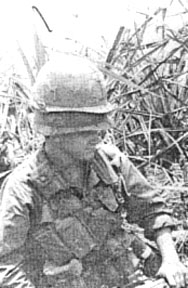 |
MAD HATTER - SP4 Danny L. Conway, 2nd Bn, 12th Inf, provides himself with double protection as the 3rd Bde, 25th Inf Div, force takes part in Operation Toan Thong northwest of Tay Ninh. (Photo By SP5 Robert Ault) |
Manchus Slug It Out With Battalion
1ST BDE - An element of the 25th Inf Div made contact with a Viet Cong
battalion-size force and drove them from their base camp after five hours of
vicious fighting.
Co B, 4th Bn, 9th Inf "Manchus", was on a reconnaissance in force mission 24
kms east of Tay Ninh when the contact was made.
"We heli-lifted into the area and moved 400 meters into the woodline and then
set up a perimeter," said SGT Robert Wofley of Modesto, Calif. "Our patrol had
just moved out about 40 meters when Charlie opened up with automatic w3eapons
from fortified bunkers," added Wofley.
The fighting was close and artillery and gunships couldn't be used
effectively. "We stayed low, holding contact and slugged it out with them,"
said SP4 John Uzarski of Twinsburg, Ohio. The fighting lasted for five hours.
RAISE DUE JULY 1
WASHINGTON - The new pay rates expected to go into effect on July 1 will
bring monthly raises to active duty men ranging from $6.60 for a recruit to
$160.80 for a member of the Joint Chiefs of Staff. The senior enlisted man in
each service will get a $58.20 raise to $902.40 monthly basic pay. The recruit
pay goes from $95.70 to $102.30 and the Chief of Staff from $2332.20 to $2493
per month.
The 6.9 percent raise in basic pay will affect the rates of pay for cadets
in the academies, the payment of Dependency Indemnity Compensation to widows of
active duty men, reenlistment bonuses, retired pay and other elements of
compensation calculated on the amount of basic pay.
If this raise comes about as expected it will be the sixth hike in basic pay
for military men in as many years. There was no basic pay increase between 1958
and 1963.
This year's pay hike is expected to cost the government $951 million the
first year.
These figures represent the 6.9 percent hike in basic pay which is slated for
enactment July 1.
There is still a possibility that the hike may be a tenth of a percent
different from that figure, but officials say they would bet 10-to-1 that the
6.9 percent raise will hold. There is also a chance that the effective date
will be later than July 1, but that date, too, is the best bet.
The Defense Department has asked the Comptroller General to decide whether
July 1 or a later date is proper under the pay act passed last year which would
give military men a raise when civil servants get one.
|
July 1, 1968, Basic Pay Rates |
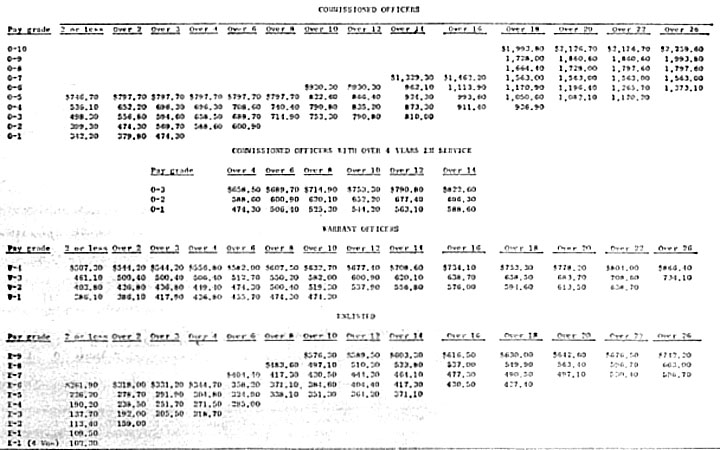 |
This Bull Not Exactly a Ferdinand
1ST BDE - An ambush by an unusual enemy taught a member of the 25th Inf Div a
touchy lesson in bullfighting.
"As we were sweeping near Hoc Mon, a suburb of Saigon, I heard a noise off
to my left flank," recalls SP4 Daniel J. Langley. "The last thing I remember
happening was seeing that bull come charging out of the bushes," added Langley,
of Pascagoula, Miss.
"Before I could get my machine gun off my shoulder and get out of the way, he
had me airborne."
"The water buffalo struck Langley from the left side and threw him for a
loop," remarked SP4 James H. Cook of Troutman, N.C. "After Langley hit the
ground, the bull started to trample him."
During the ensuing seconds the members of Alpha Co, 2nd Bn, 14th Inf,
operating under the 2nd Bde, watched as SSG James Westbrook, plt sergeant from
Columbus, Ga., fired at the bull and drove it off.
"From now on we'll expect anything out of the enemy," added a shaken but
unharmed Langley. "Even a VC water buffalo."
|
500,000th ROUND FIRED BY 1ST BN, 8TH ARTY |
||
|
||
| 500,000th ROUND - At left, ADC BG William T. Gleason, third from right, inspects the painted 105mm howitzer shell used to commemorate the 500,000 round fired by the 25th Inf Div's 1st Bn, 8th Arty, in support of 2nd Bde forces during two years of combat. Right, Gleason pulls the lanyard and the round is on the way. The ceremony took place at a forward support base of the 2nd Bde near Hoc Mon, Gia Dinh Province, during Operation Toan Thong. The 1st Bn, 8th Arty, arrived in Vietnam in Jan 1966, and has provided direct fire support for the 2nd Bde ever since. Holding their ears at right are COL Gordon Summer Jr. (far right), division artillery CO, and LTC Alan M. R. Dean, 8th Arty Bn Commander. (Photos By SP5 Gary Johnson) |
Page 4-5 TROPIC LIGHTNING NEWS May 6, 1968
67 Years of Preserving Freedom
2ND BDE - The 27th Inf "Wolfhounds" of the 25th Inf Div, celebrated their
67th birthday on May 2, and except for the date and place, it was no different
from many celebrations before it.
It was another birthday under fire, in combat in a foreign land.
Born in 1901, the 27th Inf Rgmt, now the 1st and 2nd Bns, 27th Inf., has
served in five wars to save or restore the peace in the Pacific.
On May 2, 1902, the 27th Inf broke the back of the Moro Insurrection in the
Philippines. For this reason, the opening day of the three-day Battle of Bayan
has become the Organization Day for the unit.
In 1918 and 1919, the Wolfhounds marked the end of their second decade of
service -in Siberia, where they became the first Americans to fight communism.
Nicknamed Wolfhounds by the stunned Bolshevik forces struggling to engulf
Russia, the 27th Inf became a symbol of ferocious attack, tenacious pursuit and
unflagging espirit.
Twenty-five years later, the Wolfhounds again were locked in battle, this
time storming their way across the Pacific from Guadalcanal to Luzon.
Fighting in the cold, hard, bitter years of the Korean War, the Wolfhounds
earned the reputation as the "finest fighting machine in the U.S. Army."
In 1966, the 27th Inf battalions landed in Vietnam and fought their way to Cu
Chi. Dodging a constant barrage of sniper fire and mortars, the Wolfhounds
established the huge base camp of the 25th Inf Div.
Their record of service is unsurpassed: the 27th Inf Rgmt holds three
Distinguished Unit Citations, four foreign Presidential Unit Citations, a
Valorous Unit Citation and 17 campaign streamers earned in battlefields
throughout the Orient.
Among the men who served under its colors are GEN of the Army John J.
Pershing and Omar Bradley, and MG Frank Baldwin, winner of two Medals of Honor.
But the Wolfhound story is not merely one of valor and sacrifice and success
in the field; it is also a story of benevolence in victory.
Wherever they have fought, the Wolfhounds have acted as individuals and as
units to ensure the development of the people they have beaten.
Nowhere is this more evident than in the Holy Family Home in Osaka, Japan,
where on Christmas 1949, the men of the 27th Inf found 140 Japanese war orphans
huddled in three tarpaper shacks.
Each payday since then, Wolfhounds in time of war or of peace, have
contributed to the orphanage. Helping them have been the men of the 1st Bn, 8th
Arty, who fought with the 27th Inf during World War II, Korea, and again in
Vietnam.
The orphanage, generally considered one of the finest in the Orient, has
become the scene of a yearly pilgrimage.
From Mindanao in the Solomons, from Heartbreak Ridge to Cu Chi, the 27th Inf
Rgmt has earned its motto: Nec Aspera Terrent - "No Fear on Earth."
Its highest tribute, however, comes from a grateful nation and a grateful
state that has adopted it as its own. The tribute is best evidence by that
state, which this year passed a resolution honoring the Wolfhounds for their
years of service.
"Whereas the 27th Inf (The Wolfhounds) has distinguished itself not only in
battles to preserve our freedom, but has distinguished itself not only in
battles to preserve our freedom, but has become famous for its humanitarian
effort . . . Be it resolved by the Senate of the Fourth Legislature of the State
of Hawaii . . . that it expresses its appreciation to the men of the 27th Inf
(The Wolfhounds) on the 67th birthday of their organization for their many
sacrifices to preserve the freedom of the Nation."
| Troopers of the 2nd Bn, 27th Inf, leap from a 25th Inf Div helicopter as it
sweeps into a landing zone during Operation Kole Kole. (Photo By SP4 Joe Carey)
|
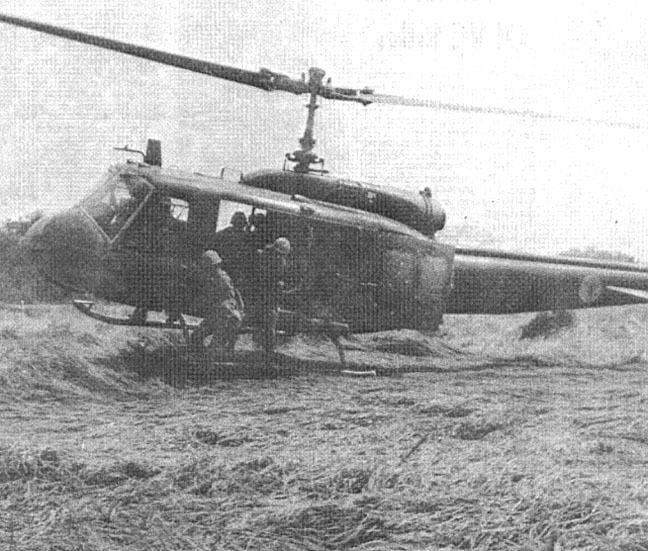 |
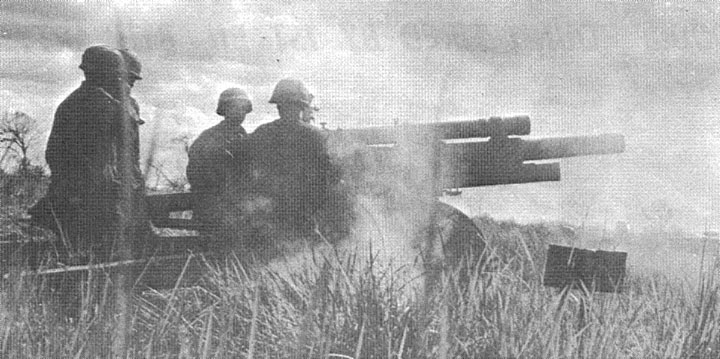 |
| A 105mm howitzer of the 1st Bn, 8th Arty, fires in support of the Wolfhounds during Operation Kole Kole. (Photo By 1LT Bruce Burton) |
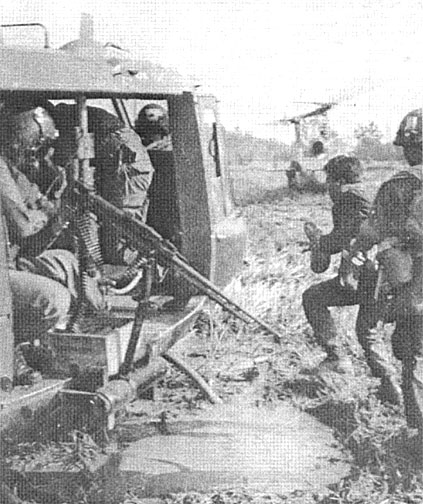 |
Wolfhounds and a Vietnamese interpreter scramble to waiting helicopters
during Operation Saratoga. (Photo By SGT Ross Roessler)
|
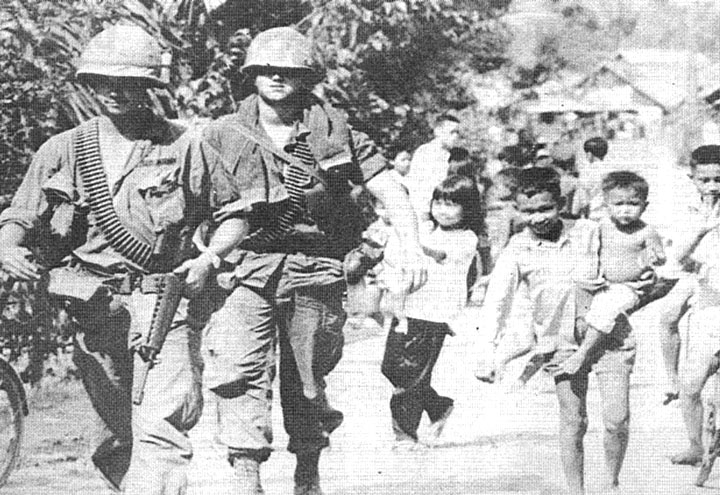 |
| Like Pied Pipers, a pair of Wolfhounds march through Hoc Mon during Operation Quyet Thang, surrounded by children. (Photo By SGT Ross Roessler) |
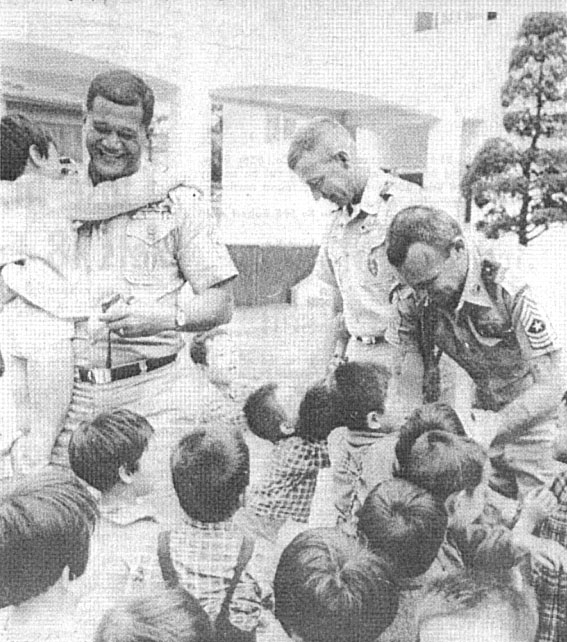 |
A trio of men from the 1st and 2nd Bns, 27th Inf, and the 1st Bn, 8th Arty, visit with children of the Holy Family Home in Osaka during a 1966 Christmas visit to Japan. (US Army Photo) |
Page 6 TROPIC LIGHTNING NEWS May 6, 1968
Respect The Rights Of Others - LAW DAY
There are men in today's Army who can remember when May Day - the first day
of the fifth month - was celebrated as a festival honoring the arrival of full
springtime. Flowers were the mark of May Day, then . . .
But that was back before World War I.
In the wake of that conflict came a new kind of May Day, spawned by the
forces that made Soviet Communism. Instead of flowers and happy times, Red May
Day featured weapons and threats directed toward the rest of the world which
remained free. A clenched fist of lawless power replaced the open hand of
friendship.
Ten years ago President Eisenhower, at the behest of the law-minded and
law-abiding citizens of our country, established still a third kind of May Day.
It was - and is - Law Day, USA.
Law Day, this year, fell on Wednesday, 1 May 1968. Its theme, as announced
by a Presidential Proclamation, is: "Only a lawful society can build a better
society."
Its purpose is to remind us of the debt we owe to the law under which we
live: to our law, for it has been shaped and polished by the citizens of
America, working through our openly elected representatives, chosen by us to
make laws which govern us.
On Law Day each citizen should make a personal commitment to obey the law; to
respect the rights of others; to aid law enforcements officers; and to uphold
the judgments of the courts.
If there is one single thing that sets the Free World apart from the tyranny
of Communism it is law in action. Under democracy, the people establish their
own laws through their own representatives. They are able to change those laws
as the need arises.
But under Communism it is the law which is the master of the citizen, and it
is a harsh, cruel, and tyrannical thing with which to live.
No Help, No Hope
To understand how much our law means to you, try to imagine this situation.
You and your family are at home asleep. Suddenly there is a loud hammering
on the door. It jars you awake, and frightens your wife and children. You look
at the clock. It is 3:30 in the morning.
Still half asleep you go to the door and ask who is there.
"Police," comes back a voice. "Open up."
You unlatch the door. It is slammed back at you so hard you bounce against
the wall. Before you recover your balance a burly cop grabs you by the hair and
jerks you to the floor. Other cops are pouring in from the street. You start
to get to your feet.
Another policeman kicks your legs out from under you. A third boots you, in
the face as you lie there.
You obey when they tell you to remain quiet.
You lie there while you hear your wife screaming upstairs, and your kids
shrieking in fright, and while you watch and hear the cops rip your home apart,
searching for something they do not find.
You lie there and think. They are not nice thoughts.
You know, absolutely and without question, that you are not guilty of
anything. And you also know that it will be up to you to prove it, because the
law of your land presumes that you're guilty until you prove yourself otherwise.
You know you will not get a lawyer to represent you. You know you will be
imprisoned until the authorities get around to your case. You know you will not
have an open, public trial. You know you will have no chance to confront your
accusers, nor to cross examine them.
You know you can be sentenced at the court's whim to anything up to life
imprisonment, or even to death - and with no hope of appeal. You know that
everything you own can be confiscated, and your wife and kids kicked out into
the street, with nothing, to be common laborers if they're lucky, and to starve
if they're not.
And you know that your case is not very unusual, because literally millions
of your fellow citizens have received the same treatment.
That is the way it is for countless people who live under the savage legal
codes of Communist or other dictator countries.
The Law Protects You
In reality you are one of the luckiest people on this earth: Lucky because
you live under a law which is designed to protect the honest citizen, not only
against wrongdoers, but even against his own government.
It has been said that the law is something like the air: it constantly
surrounds us, and we are usually not conscious of it, yet without it we could
not survive.
For our law protects and fosters individual freedom.
The truth of this is evident all around you.
Every church you see stands there as a monument to religious freedom - under
the law. Each newspaper you read is a living expression of a free press - under
the law.
The public libraries and schools that abound are symbols of the freedom to
learn - under the law. The town meeting you attend is freedom of speech under
the law. Every town courthouse is the home of equal justice for all - under the
law.
There are very few nations left where this is true. And that is one reason
why countries which adhere to these ideals, are collectively known as the "Free
World."
The Development Of Our Law
Nobody gave us the law under which we live so freely. Our fore-fathers, and
theirs before them, had to work for it.
Our law is a curious mixture of Old Roman, dating back before the time of
Christ, with Anglo-Saxon customs developed in South Germany, added to
Norman-French common law. These systems became blended in the England that
began to arise from the Dark Ages of western civilization.
Out of them, after almost seven centuries of experience, came the laws of
England. These laws, adopted and modified to American needs during our almost
two hundred years of independence, have given us the jurisprudence we enjoy
today.
In very simplified form, Roman Law gave us the concept of a codified legal
system in which the laws were created by a legislative body specifically
established for this purpose.
From the Anglo-Saxons we inherited the dim beginnings of the idea of judgment
only by our peers. And the Norman-French brought us the basics of the
relationships between the governing and the governed.
When the Thirteen Colonies broke free from England, they took with them a
heritage of law as a thing of the people.
Law, American Style
Our country's contribution to law was the Constitution and the Bill of
Rights. This is the oldest existing legal system which, in writing, expresses
the basic concepts of governmental legality and the relationship of the citizen
to his government.
It is such a near-perfect creation that a majority of countries have tried to
copy it for their own use. Where they have followed its spirit, those countries
have provided better government for the majority of their people.
It is under the Constitution that we, as citizens, are guaranteed the concept
that we are presumed to be innocent until we are proven guilty . . . and are
entitled to legal counsel of our choice . . . and to speedy trial, conducted by
an impartial and independent judiciary . . . before a jury composed of our peers
. . . and with the assurance of an open, public trial . . . and the right to
know, and cross-examine, those who accuse us . . . with full protection of our
right to appeal . . . and with a guarantee against cruel and unusual punishments
. . .
Probably four out of five people in this world would give anything to live
under such protection. What we and the rest of the Free World have in our laws
and our judicial systems is beyond price.
We are lucky. We have inherited a fair and just law. We should never forget
this truth: Only a lawful society can build a better society.
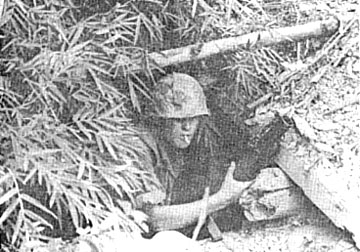 |
NO ONE HOME - SP4 Arnold Bergstrom, C Co, 65th Engs, works with the 2nd Bn, 12th Inf, in checking out an enemy base camp the 3rd Bde, 25th Inf Div, force found northwest of Tay Ninh on Operation Toan Thong. (Photo By SP5 Robert Ault) |
3rd Bde Mobility Proving Itself
3RD BDE - Mobility, the U.S. Army's number one asset in Vietnam. The 3rd
Bde, 25th Inf Div has proven its mobility many times ever since the first of
Dec, when the Bde Command Post and Hqs elements began touring War Zone C.
First it was to Soui Tre, the site of the Bde's battle with an NVA force last
Mar. But, in Dec, the VC and NVA had abandoned the area. Two weeks of
operations turned up only 4,500 hand grenades and a few booby traps.
Then, the Bde CP moved to Fire Support Base Burt, 12 kms from the Cambodian
border. For the first few days it seemed as though the enemy was not there
either. Then, on the night of New Years Day, elements of the 271 and 272 NVA
Regiments attempted to overrun Burt. The New Year began with the Bde killing
over 300 of the enemy that night and over 500 for the three weeks in the area.
The Bde then returned to Dau Tieng.
Time in the base camp was short as the men were called for duty against the
VC and NVA units north of Tan Son Nhut early in the Tet offensive. The task was
to take the offensive away from the enemy and clear them out of the Tan Son Nhut
area.
Commanded by COL Leonard R. Daems, the 3rd Bde units found and destroyed
large numbers of the enemy, pushed them out of their strongholds and away from
the populated areas. Dozens of 122mm rockets, mortar rounds and numerous
weapons were seized from the enemy. During these operations, the Command Post
moved three more times.
Finally, after almost four months in the field, the 3rd Bde, 25th Inf Div CP
has returned to base camp, still mobile, still ready to go after Charlie.
Close in Fighting Nets 18 For Hounds
2ND BDE - A company of the 25th Inf Div killed at least 18 members of an
entrenched Viet Cong platoon it encountered at point blank range during an
Operation Quyet Thang sweep near Saigon.
Co C, 2nd Bn, 27th Inf "Wolfhounds," operating under the 3rd Bde, engaged the
enemy unit only 10 minutes after it landed in canal and rice paddy country near
Hoc Mon, a suburb northwest of Saigon.
According to 1SG Henry C. Klaput of Marina, Calif., the action began when the
company's point man, SP4 Larry Johnson of Prattville, Ala., spotted and shot a
Viet Cong less than 10 meters to his front.
CPT Robert W. McClellan, Co CO from Summit, N.J., called for helicopter
gunship support, then maneuvered his troops against what they soon discovered to
be a series of enemy fortifications.
McClellan described the fighting as "pretty heavy," adding that many of his
men were firing less than 20 feet from the enemy bunkers.
"We were so close we were throwing grenades underhanded," Klaput said.
After seven hours of fighting, McClellan pulled the company back to wait out
the night. Sweeping through the area the next morning, they found 18 Viet Cong
bodies and captured several weapons.
The company commander praised his first sergeant for doing "an outstanding
job. He was throwing hand grenades and getting his men together despite heavy
fire."
Klaput later said he thought the Viet Cong were at first trying to avoid a
fight.
"I'm surprised they didn't open fire on us as we were landing. I really
think they were hoping we would miss them in the bunkers, but when Johnson got
too close, they had to fire," he said.
USAF FACS SET RECORD WITH 25TH
CU CHI - U.S. Air Force forward air controllers (FAC) flew a record number of
hours last month in support of 2nd Bde, 25th Inf Div troops.
MAJ Douglas B. Brittain of Alexandria, La., said his team from the 19th
Tactical Air Support Squadron at Bien Hoa flew 472 hours last month, compared
to 440 hours during the heavy Tet fighting in February.
During the heaviest fighting of the month, the three day Battle of Trang Bang
which began on March 24, the FAC's directed virtually round-the-clock air
strikes in support of ground elements.
In the 162 air strikes directed by the 2nd Bde FAC's, jet fighter bombers
dropped high explosives on enemy troop concentrations, fortifications and supply
areas, Brittain said.
Additionally, bomb damage assessment includes 354 bunkers, 106 military
structures and 355 meters of trenchline destroyed; 93 bunkers and 19 military
structures damaged; 790 meters of trenchline, 65 spider holes, 12 tunnels and 21
fighting positions uncovered.
Page 7 TROPIC LIGHTNING NEWS May 6, 1968
ARMY NG CPT DECIDES TO SERVE IN VN
CU CHI - A Connecticut Army National Guard captain who felt he could best
serve his country on active duty is currently serving as the commanding officer
of Co A, 65th Eng Bn, 25th Inf Div.
Prior to volunteering for duty in Vietnam, CPT Rene C. Provost of Danielson,
Conn., was the commanding officer of the 250th Eng Co of the Connecticut Army
National Guard.
"I felt that I had sufficient training, and that what our country was doing
in Vietnam was right." said Provost. "I also felt that a man should serve his
country in the best way he can."
As the commanding officer of Co A, Provost will be in charge of engineer
teams which are directly supporting infantry units in the field.
According to Provost this direct support consists of providing mine clearing
teams to keep the road open to truck convoys between Cu Chi and Trang Bang, 18
kms west of the division's base camp, destroying Viet Cong tunnels and bunkers
as well as building bridges over streams that would otherwise be impassable.
Of his assignment to Co A, Provost says, "Being assigned to a line unit I get
a truer picture of what we are doing over here."
34th Armor Powerful At Trang Bang
TAY NINH - The battle of Trang Bang, 54 kms northwest of Saigon, proved a
classic example of Armor's ability to gain and maintain contact as a task force
of the 2nd Bn, 34th Armor, fought a continuous battle of over 50 hours.
The task force consisted of Co C, 1st Bn (Mech), 5th Inf, and Co C of the 4th
Bn (Mech), 23rd, with recon elements and tanks of the 34th Armor spearheading an
offensive drive north of Trang Bang which killed 71 North Vietnamese soldiers.
The 25th Inf Div task force engaged elements of the 9th North Vietnamese Army
(NVA) Div during the afternoon and did not break contact until two days later.
As the fighting raged on into the night the units were able to continue their
devastating fire power and assault en masse with the aid of illumination from
the tanks, air strikes, and gunship assaults.
The task force relentlessly routed the enemy from his concealed bunkers.
Fighting day and night the units drove the enemy from his advantage point on a
hill and continued to pursue him.
Since the completion of Operation Yellowstone, the 2nd Bn, 34th Armor, has
successfully conducted offensive operations in the Tan Hoa area, Thai My, and Ho
Bo Woods areas.
LTC John Tipton, commanding officer of the 2nd Bn, 34th Armor, attributes his
units achievements to the ability, courage and tenacity of his men combined with
Armor's inherent capacity to reach quickly with massive fire power.
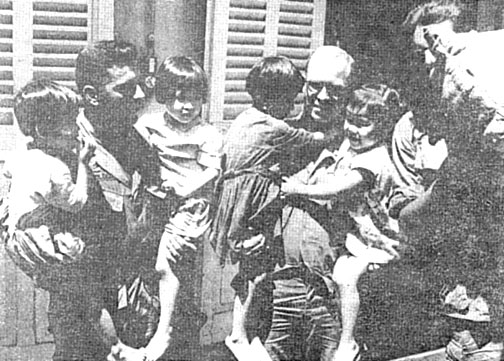 |
HAPPY HOME - CPT John J. Theologos, left, and 1LT Stanley McKee, play with
orphans at the Viet Hoa home in Saigon, while a trooper of the 25th Inf Div's
1st Bn (Mech), 5th Inf, carts off a bag of rice donated by the battalion.
(Photo By SP4 Jake Southwick)
|
2nd Bde CPT and Chaplain Aid Orphanage With Money, Rice
2ND BDE - A 25th Inf Div CPT recently returned to the former home of his
adopted Vietnamese daughter, bringing with him five tons of rice and a Catholic
chaplain with a $1,000 gift.
CPT John J. Theologos of New York, a former company commander with the 1st Bn
(Mech), 5th Inf, and Chaplain (CPT) Robert Falabella of Washington, D.C., Bn
chaplain, delivered the rice and money to the Viet Hoa Orphanage in Saigon.
For Theologos, it was a sentimental journey. Stationed near Saigon during
his first tour in Vietnam in 1963-1964, the 2nd Bde officer experienced "one of
those love at first sight affairs" during a visit to the orphanage.
Instead of taking an R & R leave that tour, Theologos spent a week in Saigon
and adopted a 19-month old girl, who now lives with his family in New York.
When the Tropic Lightning battalion recently discovered a huge enemy base
camp and rice cache in the Filhol Plantation during Operation Quyet Thang,
Theologos suggested a part of the rice be donated to the orphanage.
LTC Thomas C. Lodge of Deland, Fla., agreed, and gave the captain full
permission to organize a truck convoy to carry the food to the orphanage.
Falabella, meanwhile, had received $850 from a Catholic church at Ft. Knox,
Ky., and instructions "to donate the money to a worthy cause."
Remembering the orphanage and Theologos' adopted child, the priest asked to
go along when the battalion donated the rice. Adding $150 out of his own
pocket, Falabella presented the $1,000 gift to the grateful sisters and children
of the orphanage.
Singapore Shots
SINGAPORE (AP) - The government has declared Singapore a cholera-infected
area after a 66-year-old laborer was stricken with the disease. Inoculations
are being checked on incoming personnel.
 |
IN FINE SHAPE - Showgirl Jeanne Carroll, who really believes in sweaters,
spends her time in Las Vegas, Nev., appearing in musical comedy spectaculars. |
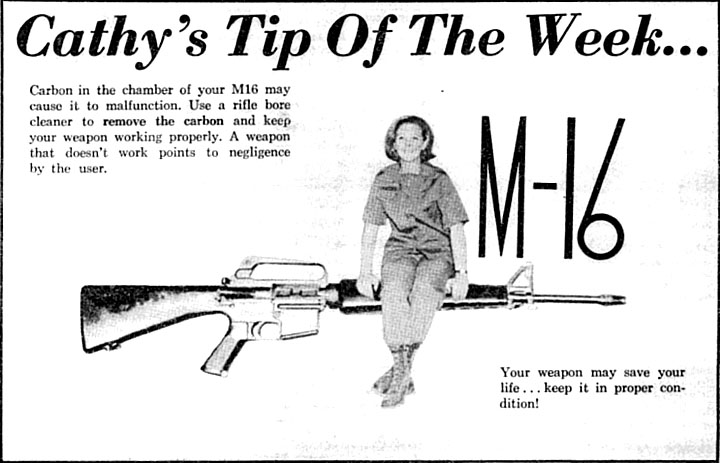 |
Page 8 TROPIC LIGHTNING NEWS May 6, 1968
14 VC Killed By Roving 3/22
3RD BDE - Viet Cong who throw rocks don't last long against troops of the 3rd
Bn, 22nd Inf, of the 3rd Bde, 25th Inf Div.
What began as a night ambush patrol near the Saigon River for Charlie Co
turned into a strange game of hide-and-seek for the "Regulars" company.
"We mortared our ambush site, a small island, just before moving into it in
order to scare off any VC that might have been there," explained 1LT Charles J.
Boyle, Co CO from Detroit, Mich.
"We must have scared them (the VC) off with our mortar fire," continued
Boyle, "because they swam back out to the island and began to probe our position
by throwing rocks into the area."
At this point Boyle called in for an artillery illumination round over his
position. When the round burst into light, the VC froze in their tracks, and
the Americans opened fire. The result was five enemy body count.
Nine VC
Even heavy camouflage didn't help a VC sampan escape night ambush by the
Regulars.
Having set up along the bank of the Saigon River, Bravo Co's first Plt
proceeded to intercept two communist sampans during the course of the night.
The first came downriver soon after dark, only to meet a hail of fire from
the Plat's machineguns and small arms. Two VC bodies were recovered.
Undeceived by the camouflage, the Regulars cut loose on the floating
"greenhouse" and scored seven more Viet Cong killed and another sampan put out
of commission for good.
'Coach' Holbrook Calls Plays
1ST BDE - A 25th Inf Div master sergeant was calling signals just like a
football game back home, except enemy bullets were cracking overhead and his
only refuge was a haystack.
Co B of the 2nd Bn, 14th Inf, was preparing to assault the right flank of an
enemy bunker line in a 2nd Bde battle 48 kms northwest of Saigon.
According to 1LT Michael S. Tooke of Lakeview, Ore., "Most of the company had
moved up on line and down behind a large dike."
When the company airlifted into rice paddies near the enemy fortifications, a
group of soldiers took cover to the rear of the main body of the company. MSG
Samuel O. Holbrook, the company's top sergeant, dashed to the rear and took
cover behind a haystack.
"A haystack was the only protection 'Top' could find, so that's where he
went," recalled SP4 John A. Quatroke of Algonquin, Ill. "Bullets were going
right through the hay, but at least he could kind of hide from the VC while he
directed us."
From behind the haystack, blowing a whistle and shouting encouragement,
Holbrook maneuvered the soldiers toward the main assault line.
"We had just got off the choppers when we received fire from our front and we
grabbed the first protection we could find," said SP4 Roy G. Tweed.
"Top came back for us and when he started blowing his whistle, we knew just
what to do."
"He wanted us to get on line, and if it hadn't been for all the bullets
flying over our heads, I would have thought I was back in my old high school
days playing football," Tweed said.
The company later conducted a successful assault against the Viet Cong lines.
|
STANDING GUARD - An armored personnel carrier of the 2nd Bde, 25th Inf Div
stops near the wreckage of a house as Operation Quyet Thong troops overrun an
enemy-held village 50 kms northwest of Saigon. (Photo By SP5 Gary Johnson)
|
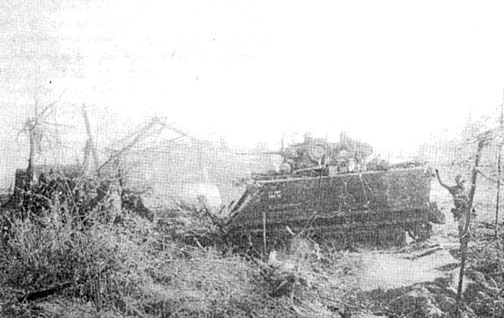 |
Camp Destroyed
2ND BDE - "Wolfhounds" of the 25th Inf Div destroyed a company-sized enemy
base camp on an Operation Toan Thang reconnaissance in force near Cu Chi.
Members of Co A, 2nd Bn, 27th Inf, destroyed 22 bunkers, 13 spider holes and
a 150 foot tunnel, reported CPT Robert Kesler, Co CO.
The Wolfhounds also found and destroyed 17 Chicom hand grenades, five
anti-personnel mines, two anti-tank rocket launchers and eight butterfly bombs.
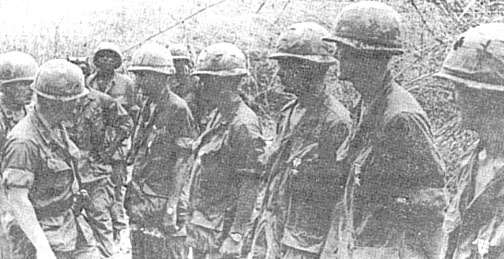 |
| COL Leonard R. Daems, at left, the CO of the 3rd Bde, 25th Inf Div, congratulates men of the 3rd Bn, 22nd Inf, on their receiving the Silver Star for their part in a battle in which the unit killed 137 Viet Cong. The men are, from left, CPT Gerald J. White, commanding officer of Co D; 1LT Richard J. Prairie, commanding officer of Co B; SFC Robert E. Nelson, Co D; SGT Edward D. Crow, Co B; SP5 Carl L. Felgenhauer, attached to Co C; and not pictured, SP4 David Chedester, medic with the reconnaissance platoon. (Photo By SP4 Paul Payne) |
Thanks to:
Robert Doty, 2nd Bn, 14th Inf.,
for sharing this issue,
Kirk Ramsey, 2nd Bn., 14th Inf. for creating this page.
This page last modified 05-06-2009
©2009 25th Infantry Division Association. All rights reserved.